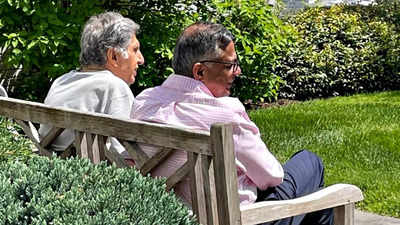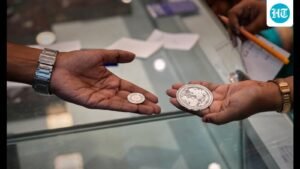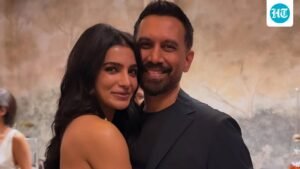

N Chandrasekaran, Chairman of Tata Sons has shared heartfelt reflections on the life and legacy of Ratan Tata, revealing the industrialist’s deep humanity, warmth, and vision. “Anybody who met Mr. Tata came away with a story about his humanity, warmth, and dreams for India. There really was no one like him,” Chandrasekaran said in a LinkedIn post, emphasizing the personal impact Tata had on those around him.
Ratan Tata, the former chairman of Tata Group, passed away on October 9 at the age of 86.He transformed the Indian conglomerate into a global powerhouse through landmark acquisitions during his tenure.
Known for his business acumen, integrity, and work ethic, Tata expanded the family business into a global empire. Under his leadership, the group’s revenues surpassed $100 billion in 2011–12, solidifying its status as a global powerhouse.
Chandrasekaran shared how his relationship with Tata evolved over the years, starting with business interactions and growing into a more personal connection. While they often discussed cars, hotels, and business matters, Tata’s attention extended beyond these topics.
Also Read | When Ratan Tata opted to be with his ailing dog over receiving an award from Prince Charles
“When our conversations turned to other matters—those of daily life—he would show how much he noticed and felt,” Chandrasekaran reflected. He noted that Tata was someone to be discovered slowly, through experience, a trait that was evident in his approach to leadership as well.
Chandrasekaran, shared a memorable experience from 2017 when he collaborated with Ratan Tata to resolve a long-standing wage dispute between Tata Motors and its employees’ union. During a meeting with union leaders, Tata expressed regret for the delay in resolving the issue, explained the company’s challenges, and promised a swift resolution.
“Mr. Tata’s direction squarely focused on making sure employees were well taken care of—not just to resolve the dispute, but to ensure their and their families’ well-being,” Chandrasekaran said, noting how Tata’s compassion for employees was a defining characteristic. across all Tata Group companies.
Chandrasekaran also shared an anecdote about the renovation of Tata’s iconic headquarters, Bombay House. When Chandrasekaran approached Tata about the renovation plans, Tata’s primary concern was the well-being of the stray dogs that had become a familiar sight at the reception.
Tata asked, “May I ask you something? When you say ‘renovate’, do you mean ‘vacate’?…Where will the dogs go?” Chandrasekaran assured Tata that a kennel would be built to accommodate the dogs, which seemed to delight him.
“When the renovation of Bombay House was complete, Mr. Tata wanted to see the kennel first,” Chandrasekaran recalled.
Tata’s satisfaction with the thoughtful design of the kennel was a reminder of his attention to detail and the values that guided him. “Seeing his happiness with the kennel… was confirmation that we had done the right thing.”
Chandrasekaran also highlighted Tata’s exceptional memory and keen attention to detail.
Also Read | When Narayana Murthy touched Ratan Tata’s feet
As Chandrasekaran continues to come to terms with Tata’s absence, he concludes with a powerful reflection: “His eye received everything clearly, as his mind perceived everything clearly.” These words underscore Tata’s legacy as a visionary leader who not only shaped India’s industrial landscape but also touched the lives of countless individuals with his thoughtfulness and empathy.
Below is the full text of N Chandrasekaran’s LinkedIn post:
Anybody who met Mr. Tata came away with a story about his humanity, warmth, and dreams for India. There really was no one like him.
Our relationship grew over the years, first focusing on business and eventually evolving into a more personal connection. We discussed interests ranging from cars to hotels, but when our conversations turned to other matters—those of daily life—he would show how much he noticed and felt. He was someone to be discovered, over time and through experience.
I remember several such instances.
Just after I became Chairman, I was introduced to a situation within Tata Motors which involved a dispute between the company and the employees’ union over wages for two years. In March ’17, Mr. Tata and I met the union leaders together. During the meeting, Mr. Tata relayed three messages: He regretted the delay in finding a resolution. He explained that the company was passing through hardship. And both of us committed that this dispute would be concluded within a fortnight.
Mr. Tata’s direction focused squarely on making sure employees were well taken care of—not just to resolve the dispute, but to ensure their and their families’ well-being. Across other Group companies, his perspective on employees was uniform. It is something that has shaped a number of our leaders across the Group.
Around that same time, I expressed a desire to renovate our headquarters, Bombay House. Bombay House had not been touched since 1924, and more important (as many people told me) Mr. Tata would not like it. “Bombay House is a temple,” I was told, emphasizing its sanctity.
When I finally mentioned to Mr. Tata about Bombay House, he said, “May I ask you something? When you say ‘renovate’, do you mean ‘vacate’?”
I explained that we planned to move everyone to a nearby office.
He gently clarified: “Where will the dogs go?”
The dogs were an integral part of Bombay House, often seen at the reception.
“We will build a kennel.”
“Really?” he said, considering it.
When the renovation of Bombay House was complete, Mr. Tata wanted to see the kennel first.
He was very happy to see how thoughtful the kennel’s design was, and how well the dogs would be cared for.
Seeing his happiness with the kennel and his priorities was a reminder that while big projects are important, it’s the details that reveal how we think, what we prioritize, and how we are perceived. His joy was confirmation that we had done the right thing.
If mr. Tata ever visited a place, he could recall everything—from the placement of smallest piece of furniture, the lighting, colours, and so on. His memory was photographic. He remembered the covers and content of books and magazines and referred to them even years later. He was always observing and processing, from large ideas to minute detail.
There is so much else to say about who he was, but for now, as I process his absence, this will have to do: His eye received everything clearly, as his mind perceived everything clearly.







